| DATELINE |
| Time |
Events |
| 200 BC |
"Przeworsk culture", a complex of incompatible and distinct cultures dated from 2nd
c. BC to 5th c. AD, attributed to "Vandals named by ancient geographers, and other
"eastern" peoples". In addition to nomadic Vandals, another identified population were
Germanic groups, provisionally Slavic Lugi, and suspected Celtic groups. Most prominent
are Vandal opulent burials, overshadowing graves of Germanic groups. Vandal part of "Przeworsk
culture" declined in 5th c. AD with Hunnic takeover of Eastern and Central Europe |
 |
| 13 BC |
Allusion in Ammianus Marcellin 28.5.10-11 and Paulus Orosius (ca 375 - ca 418,
l. vii. 32): that Burgunds believed that
they are constituents of Romans, Roman descendents, probably brought in by Drusus and
Tiberius (Drusus Julius Caesar 13 BC–23 AD, Tiberius Julius
Caesar Augustus, 42 BC – 37 AD ?) However, Burgund ethnology is purely of
nomadic horse pastoralist character, nothing like Roman ethnology |
| 70 |
Pliny the Elder (23 – 79 AD): Germans (at that
time Germans was politonym, not ethnonym, and held as Celtic people) are five kinds; Vindili, some of whom are Burgunds, Varini, Carini, and Guttones;
(Hist. Natur. iv. 28, 14?.Germanorum genera quinque; Vindili, quorum pars Burgundiones...).
(Taking for full value testimonies of Pliny the Elder and Agathius, Onogurs = "10
Tribes" later known as Bulgars extended into Central Europe; hence Vindili <
Vandals; Burgunds < Burguzes, Bazgun;
Varini < Barynes = Savir dynastic tribe; Guttones
< Guzes = "Tribe", Oguzes, aka Guties; and hence Vandals < wendeln, "to wander" was a collection
of nomadic tribes, i.e. Sarmats). Tacitus (56 – 117 AD,
Germania, 2), meanwhile, states that Marsi,
Gambrivii, Suevi, and Vandali were add-on Germanic tribes: "That of Germany, on the other
hand, they assert to be a modern addition; for that the people who first crossed the
Rhine, and expelled the Gauls, and are now called Tungri, were then named Germans", and
spread that name to other tribes
(In Türkic, German is "strong", i.e. Strong Tribe, synonymous
with Bash = Head i.e. Head Tribe, and with Ak = White i.e. Grand, Noble
Tribe; Tungri ~ Turingia/Thuringia can be speculated as cognate of Tengri = Heavenly, or just Türk/Türkia; Varini,
in particular, venerate Mother Earth, which is know as Türkic deity Yer [Tacitus, Germania, 40].
On top of that, Tacitus introduces non-German Pannonian language: "Osi prove
themselves not to be Germans;... [they are] of the Pannonian tongue [Tacitus, Germania, 43];
Osi < Türkic Ases, in Assyrian As-Guzes = As Tribe. Combined, all this direct and
indirect evidence lines up into a cohesive systematic scheme) |
| 90 |
Tacitus includes provisionally Slavic Lugi (Slav. lug = meadow)
into Vandal union. For provisionally Slavic Lugi, the Vandal- Lugian alliance may have
initiated Turkification of Pra-Slavic vernacular. |
| 100 |
Protracted war between Longobards and Vandals. Another protracted war
between Goths and Vandals is reflected in Gothic saga, as result of war Gutones
separated from Lugian-Vandal community and moved from Pomerania to Vistula. These wars
corroborate that Vandals were aliens to both Longobards and Goths. |
| 125 |
It is thought that Burgunds were pasturing along Oder-Vistula interfluvial |
| 171 |
Another Vandal tribe, Hasdingi, requested Trajan's permission to enter
Trajan's Dacia under military kings Ambri and Assi. Both names may reflect the names of
their tribes, Assi ~ Osi ~ Aesir. Aesir was known as a leader of one of Gothic tribes
Amal. (Türk. "mal"- cattle, a protector of shepherds, equivalent
of St. Drogo in Catholic hierarchy, later known from annalistic sources as a name of a
tribal leader of Baryns and a tribal leader of Agathirs, Germanic Tervingi, Slavic
"Drevlyane"with meaning of "Forest People" in Volyn area in early Middle Age times) |
| 228 |
Burgund hordes, joined by Siling Vandals, appeared in Raetia and were defeated
by Emperor Probus 32
Captives were shipped to Britain to reinforce Roman army, the first known infusion of
Sarmatian genes into Britain.
Romans associated name Burgunds with garrisons of burgi, border
fortifications. Enmity between Burgunds and Alamani made Burgunds suitable mercenaries
for Roman imperial policy. Burgund mercenaries may be not a tribal affair, but refugees
from internecine conflicts within the tribe |
| 228 |
228-359, Burgund center remains in their Oder-Vistula interfluvial realm
for another century |
| 286 |
Some Burgunds move to Main-Neckar region. Emperor Maximian repelled Burgunds and Alamani
and some other tribes from Gaul. Burgunds moved in within limes and served as auxiliaries
for a century. |
| 350 |
Gibbon V.2 P.4 p.319: About the middle of the fourth century, the countries, perhaps of
Lusace and Thuringia, on either side of the Elbe, were occupied by the vague dominion of
the Burgundians; a warlike and numerous people, of the Vandal
(i.e. nomadic) race,
96 whose obscure name insensibly swelled into a powerful kingdom, and
has finally settled on a flourishing province. 96
People of great strength and abundantly warlike, and therefore feared by all neighbors. (Ammianus.
xxviii. 5 Bellicosos et pubis immensae viribus affluentes; et ideo metuendos finitimis
universis) |
| 359 |
Future Emperor Julian mentioned that Burgund western border with Upper
German limes run along rivers Jugst and Kocher. Burgunds
controlled border forts and as foedus defended border from Alamani and contended with Alamani
for control of brine springs |
| 369 |
Burgunds clash with Alamani for control of brine springs in Main-Neckar
region. Emperor Valentinian incited Burgunds to attack Alamani from rear while he
attacked them from Raetia. Hostilities brought Burgunds along Main to Rhine with 80,000
army. Apparently, at that time Burgunds and Vandals still retain their independence,
cohesion, language, traditions and religion |
| 370 |
Gibbon V.2 P.4 p.319: Army of 80,000 Burgundians appeared on banks of Rhine.
(At able-bodied cavalrymen comprising 20% of total population, Gibbon's
account gives incredibly high 400,000 Burgunds, pointing that Burgunds absorbed other not
heard of any more nomadic tribes like Varini, Carini, Guttones, Osi, and other unnamed
tribes). Disputed possession of some
salt-pits engaged Alemanni and Burgundians in frequent contests: the latter were easily
tempted, by secret solicitations and liberal offers of emperor; and their fabulous
descent from Roman soldiers, who had formerly been left to garrison fortresses of Drusus,
was admitted with mutual credulity, as it was conducive to mutual interest. |
| 370 |
Gibbon V.2 P.4 p.319: Burgundian massacre of captives served to embitter hereditary feud
of Burgundians and Alemanni (i.e. between nomads and sedentary
tribes). |
| 390 |
First Roman references (Ammianus Marcellinus, ca 333 - ca 400 AD, XVIII, 2, 15) placed Burgunds
east of Rhine. Notably, Marcellinus used Germanic-Türkic compound word grassabatur
for Great Batur (baĝatur), a known Bulgarian
military title, with Bulgarian dialectal contraction |
| 400 |
Burgunds brought along monotheistic Tengriism, apparently syncretic with Christianity, which Catholic Trinity-doctrinaire Church mislabeled Arianism and
accused of polytheism. Burgundian religion caused Catholic Church of Western Roman Empire
accuse them in heresy and initiate a religious war against Burgund population |
| 406 |
Alans, Vandals, Suevi, and possibly Burgunds crossed Rhine and invaded
Gaul. A fraction of Burgunds followed in wake of Vandals, crossed Rhine near Mogontiacum/Mainz,
another large fraction remained coaching along Main and later formed Burgund contingent
in Attila's army in 451 |
| 407 |
Burgunds occupied lands of Germania II along left bank of r. Rhone
between Argentorale/Strasbourg in south and Mogontiacum in north and started playing role
in Roman imperial politics |
| 407 |
Gjuki (Gebicca, Gifica, Gibica, Gebicar, Gibicho or Gippich, ? – 407)
King of Burgundians in late 4th century until his death in or around 407. Eddic poem
Atlakviða calls him Gjuki, father of Gunnar (Gunther). Prose Edda by Snorri Sturluson
says that Gjuki was father of sons Gunnar and Hogni and daughter Gudrun. Gotthorm (slayer
of Sigurd) is his stepson. As one of earliest kings of Nibelungs, his clan is called
Gjukungar. It is not hard to see in Gjuki Oghur Türk. Jükü 屠耆 ~ Wise, a high title of
Eastern Huns, and in kungar Kangar康居, the composite being Gjukungar ~ Wise Kangar. He was
father of Gundomar I, Giselher, and Gunther. |
| 407 |
Three sons of king Gjuki (Gebicca), Gundomar, Gislaharius (Giselher), and
Gundaharius (Gunther) ruled Burgundians, simultaneously or sequentially, in 410s.
Gundomar I (Gundimar, Godomar, Godemar, Gernot, Gernoz, Guthormr, 407–411) King of the
Burgundians, eldest son and successor of Gjuki (Gebicca), succeeded by his brother
Giselher (Türk. lateral succession). In Norse mythology, Gundomar I is called Guthormr,
he was killer of dragon slayer Sigurd (Sigfried). Dragon being a symbol of Türkic people,
displayed on their war standards, mythological Gundomar kills the enemy of Türkic people. |
| 411 |
Western Burgunds play role in Roman imperial politics, siding with
pretender Iovinus, a member of old Celtic aristocracy, and in conjunction with anti-Roman
alliance of Franks, Alemans, and large Roman army attacked Constantine III, a pretender from Britain, and
threatened to invade Gaul. Burgund threat helped Visigoths to obtain lands in Gaul |
| 411 |
Giselher (411–411) is king of Burgundy in Nibelungenlied, brother to
kings Gunther and Gernot. His name means "pledged warrior" (in Germanic?). Notably, Er/Her
is warrior both in Türkic and Germanic, gisel can be explained as calque, but
could be indigenous Hunnic word. |
| 411 |
Burgundian king Gundahar (Gundaharius, Gunther, Gundicar, Guntiarios,
411–436), third sons of king Gjuki (Gebicca), lateral succession after Gislaharius (Giselher).
In cooperation with Alan king Goar, set up puppet Gallic emperor Jovinus. Gundahar
settled on left or western (i.e. Roman) bank of Rhine, between rivers Lauter and Nahe,
ruling old Celtic Roman settlement of Borbetomagus (Worms), Speyer, and Strasbourg.
Emperor Honorius as part of truce officially "granted" Burgunds the land. Burgunds are
nominally Roman foederati, but regularly raid Roman upper Gallia Belgica. |
| 413 |
Burgundian king Gundahar may have actually proclaimed Iovinus an Emperor,
to gain legitimacy for Burgundian possessions. Iovinus usurpation failed, but Emperor
Honorius of Revenna formally recognized Burgunds as federati, and their possessions, in
spite that other tribes supporting pretender Iovinus had withdrawn. Visigoths were
attacking Gaul, and Revenna forces were weaker than join forces of Burgunds and Visigoths |
| 415 |
Paulus Orosius (ca 375 - ca 418): They know themselves to be offsprings
of Burgundy from ancient Roman times till now (Orosuis l. vii. c. 32 Jam inde temporibus
priscis sobolem se esse Romanam Burgundii sciunt) |
| 428 |
In 428 and 432 Aetius defeated Burgund-alied Franks |
| 430 |
Octar (Optar, d. 430), brother of Hun King Urus-Ruja Burgas (Rugila, Rua,
Ruhas, Ruga, and Rona, 414-434) and uncle of Bulut (Bleda, 434-445) and Attila
(434-453), is killed during military campaign against Burgunds.
Not a good
omen for those intransigent Burgunds |
| 432 |
Aetius again defeated Burgund-alied Franks |
| 435 |
According to tradition, Burgund capital was in Worms. Burgund kingdom
extended further north , Moselle being its northern border. In 435 Burgunds attempted to
expand westward into Belgica II, but were defeated by Aetius |
| 435 |
Aetius called in Hun mercenaries of Attila, Yabgu of right W. Wing Huns
(434-453) to campaign against Bacaudae. Reputed as Celtic, Bacauds were local population
in non-Romanised areas of Gallia and Hispania; their resistance against Roman
encroachment lasted for centuries, and they numerously defeated Roman armies; the first
rise of Bacauds against Roman conquest happened in 284, in mid fifth century they had a
de-facto state and controlled parts of Gaul and Ebro valley; Bacauds allied with
"barbarian" invaders. A notable remnant of Bagauds is a high number of Bagaud-based last
names among Itil Tatars (Bagaudov, Bagautdinov, etc.), which shows 17 centuries-long
trail of Bagauds as coherent ethnical unit, since full-blown colonization, assignment of
family names, and passportization of Itil Tatars started only in 19th c. Mute rare
references to their religion allow to suspect that Bagaud was a religious term
semantically identical to Bogomil, and the movement arose against infringing on religious
beliefs and policy of forced conversion; Bogomil was a movement of late Tengrian
monotheists against Trinity-type Christian doctrines; religious convictions may explain
Bagaud endurance and military resolve. Bagaud ready alliance with "barbarian" invaders
and escape to Türkic area of Itil basin also point to their possible original affiliation
with Türkic ethnic groups |
| 436 |
After first indecisive encounter with Burgunds, Half-Türkic Scythian Flavius Aëtius
(ca 396–454), who spent 408-423 as a hostage at the court of Karaten (Karaton 402-414)
and Urus-Ruja Burgas (Rugila, Rua, Ruhas, Ruga, and Rona, 414-434), called in Hun mercenaries
of Attila, Yabgu of right W. Wing Huns to campaign against Burgunds. Gundahar
was killed in fighting, reportedly along with majority of Burgund tribe (20,000 people).
Among Attila's subjects, and accordingly in his army, were Oder-Vistula Burgunds. |
| 437 |
Aetius moves Burgundians into Sapaudia (Upper Rhone Basin). |
| 437 |
Gundioc (Gunderic, Hun Dux ?, ca. 437–473) king of Burgundy following destruction of Worms by Huns
in 436, succeeding Gundahar. Gundioc sister married Ricimer, making him uncle of Burgund
king Gundobad (ca 452-516).Gundioc was opposed by and succeeded by his brother Chilperic
I. |
| 438 |
First Kingdom of Burgundy
443 - 534 AD
Founder - Gjúki (Gebicca)
Area - Sepaudia >> Savoy (Total Area ~ 40,000 km2)
Gibbon V.2 P.4 Ch. 17 p.89: Theodosian Code
allows to estimate extent of two dioceses of Autun and Nevers in Burgund country which
was once possessed by Celtic Aedui at 500,000 Burgundian sedentary subjects |
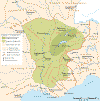 |
| 443 |
Chilperic I, brother of Gundioc (443–ca 480) opposed to his brother Gundioc |
| 443 |
Burgunds set up Geneva as their center. Historian Pline tells that
Gonderic reigned areas of Saone, Dauphiny, Savoie and part of Provence, with Vienne
capital of Kingdom of Burgundy. In all, eight Burgundian kings of House of Gundahar ruled
until kingdom was overrun by Franks in 534. |
| 443 |
Burgunds expand to Maxima Sequanorum (aka Sepaudia >> Savoy) in E.France/W.Switzerland
as Roman foederati and laeti, to protect Roman border against Franks and
Alemani in the north and Visigoths in S.Gaul. Such counterposing of Burgunds vs.
generically Germanic tribes indicates ethnical disparateness. Burgunds are split into 2
fractions, one recognized Dulo suzerainty, the other aligned with Romans. Probably,
re-united Burgunds formed a continuous ethnic massive, divided into politically separate
principalities |
 |
| 450 |
Per Priscus, Sabirs conquered lands of Onogurs, Saragurs and Ugors in steppes around
north-western Caspian coast. |
| 450 |
Agathias (ca 530-582/594 AD) mentions Hunnic Bulgars Burugundi (Βουρουγουνδοι) and Ultizurs, near relatives of Cotrigurs and
Utigurs, to tell of their destruction, while Saraguri, Urigi, and Onoguri fall victims of
Sabir power growth (Cotrigurs ~ Cuturguri ~ Cotriguri ~ Cotragi < Western Wing Köturgur)
(Utigurs ~ Uturguri ~ Utiguri < Center Wing Otragur) (Ultizurs ~
Altizurs). Thus, there is a weak link
between Burgunds and Crimea, politically Burgunds were Huns, and they are Bulgar kins,
likely one of Onogur tribes. |
 |
| 450 |
Genesis of Burgundy: The region in general consisted throughout most of its history of
area shown as Bourgogne and Provence abutting Lombardy in northern Italy on the west.
Burgundy possessions at time included many lands in Frankish region shown as Neustria,
after it passed to Phillip II of Spain it became known as the Spanish Netherlands.
That was the land of Christian Tengriism, falsely dubbed Arianism and Catharism. Burgundy abutted Lombardy in northern Italy on the west |
| 451 |
Large fraction of Burgunds that coached along Main in 451 formed Burgund
contingent in Attila's army. Another fraction of Burgunds that coached in Burgund
previous homeland in Oder-Vistula interfluvial apparently also joined Attila's army,
since Vandal part of "Przeworsk
culture" declined in 5th c. AD with Hunnic takeover of Eastern and Central Europe.
Probably, Burgund tribal center has already relocated to basin of Main river, to finally
rejoin in 542 main Burgund center along r. Rhone |
| 451 |
Part of Burgundians stayed behind in their previous homeland in
Oder-Vistula interfluvial to form a contingent in Attila's Hunnic army by 451 . |
| 452 |
Some Burgunds probably lived near Lugdunum, known today as Lyon |
| 455 |
Sidonius Apollinaris ambiguous reference infidoque tibi Burdundio
ductu implicates an unnamed treacherous Burgundian leader
in murder of emperor Petronius Maximus in chaos preceding sack of Rome by
Vandals. Patrician Ricimer is also blamed; this event marks first indication
of link between Burgundians and Ricimer, Gundioc's
brother-in-law and Gundobad's uncle |
| 456 |
Burgunds negotiated territorial expansion and power sharing arrangement with local Roman
senators |
| 473 |
Chilperic I (473 – ca 480) King of Burgundy, co-ruled with his nephews Godomar, Gundobad,
Chilperic II, and Godegisel. After death of Chilperic I , Burgundy was divided 4-way
among Gundioc sons Godomar, Chilperic II of Burgundy,
Gundobad (Gundobald) and Godegisel. Chilperic II apparently reigned at Lyon, Gundobald at
Vienne and Godegesil at Geneva. |
| 490 |
Burgund Princess Sedeleuba, sister of Frankish King Clovis second wife Queen
Clotilde (at right, stylistic distortion with facial elongation reduced), daughter of King Chilperic II of Burgundy born at Burgundian court
of Lyon, built basilica in Geneva in honor of St. Victor. Clotilde was brought up
in the Catholic. From first reference to Burgunds in 13 BC to Sedeleuba and Clotilde has passed ca 20 generations.
Typological description of Uraloid Sarmatians: low-faced meso-brachicranial with low
crania, relatively gracile, hypomorphic, underdeveloped glabellar and brow relief, nose
bridge area is somewhat flattened at nasion level, general flattening of the facial
skeleton in the horizontal plane, slight alveolar prognathism |
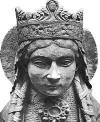 |
| 493 |
Chilperic II slain by his brother Gundobad (Gundobald), family destroyed
(Lateral succession) |
|
| 500 |
Gundobad (Godomar, ca 452-516) one of last Burgund kings. He served in Roman army and was a friends
with Vienne bishop Avitus. Gundobad uncle was Ricimer, whose tamga is depicted to the right;
Kashgari in 10th c. and Reshidedin in 13th c. identified this type tamga called bayat as
Buĝu tribe
 ,
at modern Kirgiz it is tamga of descendents of ancient Hunnic dynastic tribe Kayi,
called in Kirgiz Kaiyg |V|, and Olhovsky found it on European gravestones ,
at modern Kirgiz it is tamga of descendents of ancient Hunnic dynastic tribe Kayi,
called in Kirgiz Kaiyg |V|, and Olhovsky found it on European gravestones
 . The Buĝu tribe was tentatively
identified with Bulgars. . The Buĝu tribe was tentatively
identified with Bulgars. |
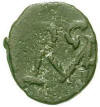 |
| 516 |
Sigismund, son of Gundobad (516–523) |
| 523 |
Godomar or Gundimar, son of Gundobad (523–532) |
| 523 |
Burgundian War: Frankish King Clovis second wife Queen Clotilde initiates
retribution for murder of her father King Chilperic II, inciting her sons against son of
Gundobad, her cousin King Sigismund of Burgundy. Sigismund was deposed, imprisoned, and
then assassinated. Burgunds fought back under Sigismund's successor King Godomar with
Ostrogoth allies, but were defeated, with permanent consequences, kingdom of Burgundy was
annexed by Merovingians. |
| 532 |
From 532 – 534 Burgunds are gradually conquered by Frankish kings Childebert I and
Clothar I |
| 534 |
Franks take Burgund capital Geneva |
| 534 |
End of First Kingdom of Burgundy
443 - 534 AD
Founder - Gjúki (Gebicca)
Area - Sepaudia >> Savoy (Total Area ~ 40,000 km2)
Gibbon V.2 P.4 Ch. 17 p.89: Theodosian Code
allows to estimate extent of two dioceses of Autun and Nevers in Burgund country which
was once possessed by Celtic Aedui at 500,000 Burgundian sedentary subjects |
 |
| 542 |
Burgunds reunite into Burgund kingdom with center along r. Rhone. Burgund
coaching routes apparently radiate from r. Rhone |
| 843 |
Sons of Louis the Pious divided Frankish kingdom in treaty of Verdun. Burgundy was
divided between brothers. Charles the Bald received smaller part, Regnum Burgundiae
(Kingdom of Burgundy) west of the river Saone. King of France delegated administrations
to Dukes, and territory became known as Duchy of Burgundy or Bourgogne |
| 843 |
Lothair I (795–855) received the larger part, east of the river Saone, which retained
name of Kingdom of Burgundy |
| 855 |
After Lothar's death his realm was divided between his sons. Lothair II, received northern parts.
Charles of Provence received southern parts including Provence, Lyon and Vienne, called
the regnum provinciae (Kingdom of Provence). Later Provence reunited with rest of Burgundy |
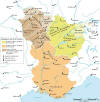 |
| 888 |
Geneva belongs to Kingdom of Burgundy |
| 933 |
Rudolph gained Kingdom of Provence, reuniting two Burgund territories. |
| 933 |
Second Kingdom of Burgundy (Kingdom of Arles, Kingdom of Arelat)
933-1033 AD
Founder - Rudolph II
Area - most of Provence and Burgundy, and Lotharingia (or (Total Area ~ < 40,000 km2) |
 |
| 937 |
Conrad I (937–993) ruler of reunited Burgundy |
| 993 |
Rudolph III (993–1032) ruler of reunited Burgundy |
| 1032 |
Kingdom of Burgundy is third kingdom of Holy Roman Empire, called Kingdom of Arles, with
King of Germany or Holy Roman Emperor of Salian (Frankish) Dynasty as King of Burgundy.
Conrad II Emperor (1027-1039), King of Burgundy (1032-1039)
Burgundy becomes crown jewel of Germany, seat of German Crown Prince |
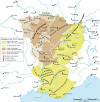 |
| 1033 |
Geneva taken by German Emperor |
| 1033 |
End of Second Kingdom of Burgundy (Kingdom of Arles, Kingdom of Arelat)
933-1033 AD
Founder - Rudolph II
Area - most of Provence and Burgundy, and Lotharingia (or (Total Area ~ < 40,000 km2) |
 |
| 1039 |
Henry III King of Burgundy (1039-1056), Emperor (1046-1056) |
| 1056 |
Henry IV King of Burgundy (1056-1105), Emperor (1084-1105) |
| 1105 |
Henry V King of Burgundy (1105-1125), Emperor (1111-1125) |
| |
|
| |
|










